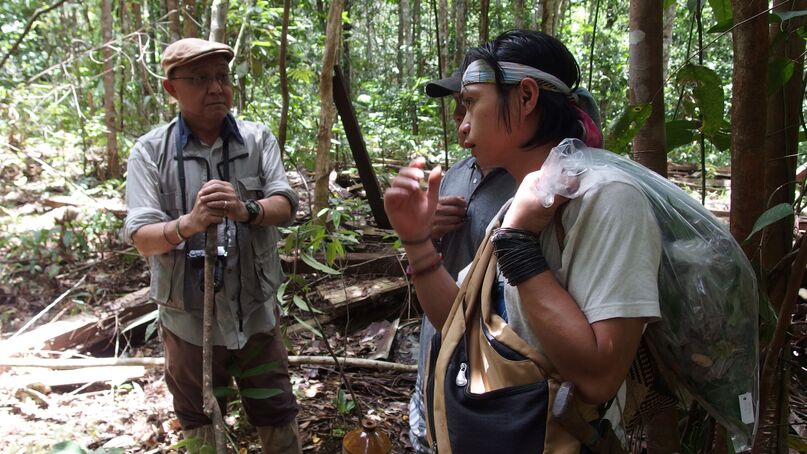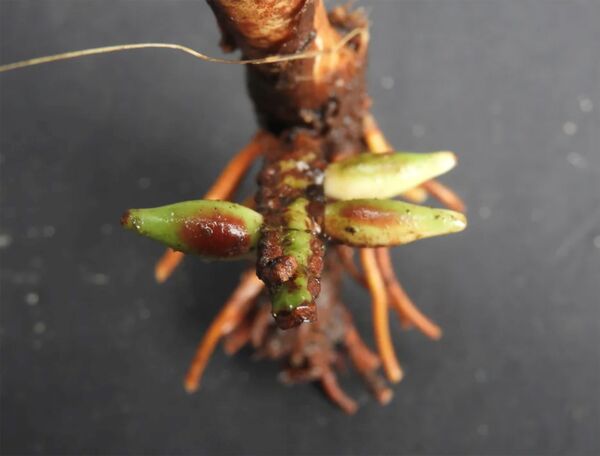New palm species “unearthed”—ITTO project scientist recalls first encounter with bizarre species
13 July 2023

Scientist and ITTO project manager Paul Chai (left) listens to Penan people during a field visit to Sarawak in 2015. Photo: W. Cluny
Kuching, Malaysia, 13 July 2023: The press is buzzing about a new-to-science species of palm in the Lanjak Entimau Wildlife Sanctuary in Sarawak, Malaysia, that flowers and fruits underground. Although long known—and used—by local people, science has only recently cottoned on. The discovery, announced in June, was originally made in 1998 by scientist and ITTO project manager Paul Chai.
“On one of my trips to the Lanjak Entimau Wildlife Sanctuary during phase 2 of the ITTO project,[1] we spent the night at the base camp beside the upper Engkari River,” recalled Dr Chai. “The forest behind the base camp is lowland mixed dipterocarp forest on gentle terrain with sandy clay soil. The palm was located about five metres from the bank of the river. It looked like an ordinary palm but I was attracted by its handsome form with lush dark green foliage and wanted to photograph it. As the stem was not visible, being buried in thick leaf litter, I brushed aside the dead leaves, and to my great surprise saw flowers and fruits hidden away in the ground. The loose sandy soil must suit the underground flowering habit well by providing the ideal environment, with sufficient space and oxygen for reproduction.”
Dr Chai said he had been excited by the discovery.
“It was the first time seeing an underground flowering plant after roaming the Sarawak forests for some three decades, and I was sure then it was new to science,” he said.
But the discovery had to wait another two decades before it came to the notice of the public.
“The photos I took were unfortunately destroyed in the big floods in Kuching in 2004,” said Dr Chai. “I forgot about the incident until Dr John Dransfield, a palm specialist from Kew, visited Sarawak with two students in 2018 and I mentioned it to them. The students went to the site and found the plant.”
The species, Pinanga subterranea, is “the only known species of palm to flower and fruit below ground,” according to Dr Benedikt Kuhnhäuser, a future leader fellow at Royal Botanic Gardens, Kew, quoted in The Guardian. Dr Kuhnhäuser was part of the team that collected specimens and ascertained that it was a new species.
According to a paper published by a group of scientists led by Dr Kuhnhäuser, including Dr Chai, the combination of subterranean flowering (geoflory) and subterranean fruiting (geocarpy) is exceedingly rare in any plant species, and neither geoflory nor geocarpy has been reported in palms until now.
According to the paper, bearded pigs dig up and eat the fruit of Pinanga subterranea, dispersing it locally in the process of digging and in their faeces. The fruit, which has a sweet, succulent flesh, is also a sought-after snack for people across the island.
Dr Chai said that findings over four phases of the ITTO project[1] have confirmed that the Lanjak Entimau Wildlife Sanctuary, which covers about 200 000 hectares, is one of the richest protected areas in Sarawak, with more than 1 500 species of flowering plants and about 600 species of fungi recorded, including other plant species that complete some of their reproductive cycle belowground.
“Although Pinanga subterranea is unique among palm species, geocarpy is a feature of other species in Sarawak, such as the fig trees Ficus uncinata and Ficus stolonifera,” said Dr Chai.
ITTO Executive Director Sheam Satkuru said the discovery of such unusual species underscores the importance of conserving and sustainably managing tropical forests.
“As a global community, we still have insufficient knowledge of the full scope of diversity in tropical forests,” she said. “Put simply, we are not sure of exactly what we have, which is critical as we will then know what we will exactly lose if the forests disappear. This biodiversity is both precious in its own right and a valuable resource for humanity in the future.”
Dr Chai said that Pinanga subterranea has also been found in the Upper Baram in northeast Sarawak.
“The ethnic Kenyah tribe there chew the fruits with betel leaves when the usual areca nuts (Areca cathethu) are not available,” he said. “It is possible that the palm is common but would usually be thought of as a juvenile without seeing the underground flowering. That was also what I thought when I first saw the plant.”
Ms Satkuru said there is still a great deal to do to ensure the sustainability of tropical forests and the conservation of their biodiversity.
“ITTO has a proven record of supporting member countries across the tropics to conserve and sustainably use their rich tropical forest resources, but we all must do much more or these natural wonders may not stand the test of time,” she said.

The exposed roots and fruits of Pinanga subterranea. Photograph: Royal Botanical Gardens, Kew
[1] Four ITTO projects have operated consecutively in the Lanjak Entimau Wildlife Sanctuary, spanning 1992 to 2012: PD106/90 Rev.1 (F) (phase I), PD015/95 Rev.3 (F) (phase II), PD016/99 Rev.2 (F) (phase III) and PD288/04 Rev. 2 (F) (phase IV). More information and outputs of these projects can be found by inserting these codes in the ITTO project search function at: www.itto.int/project_search